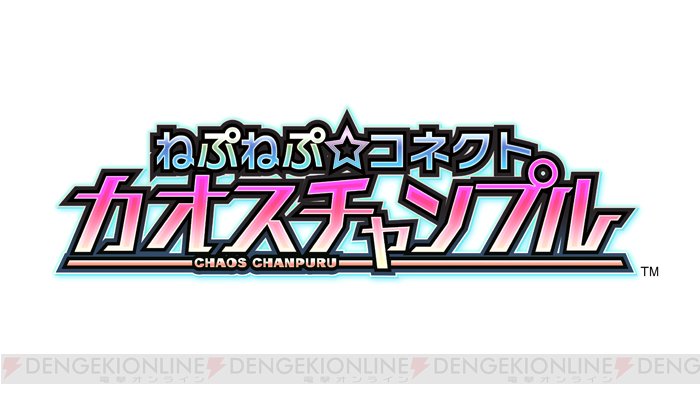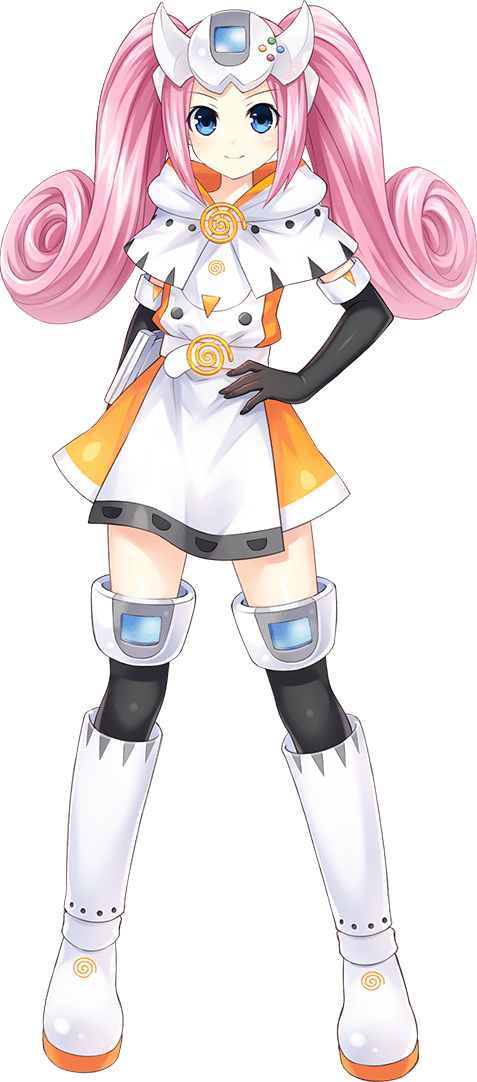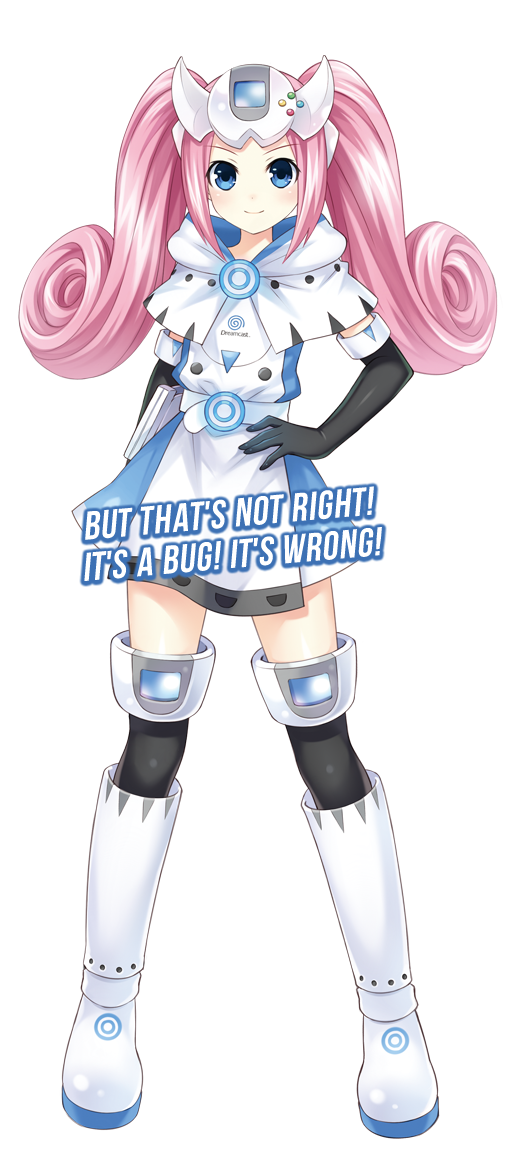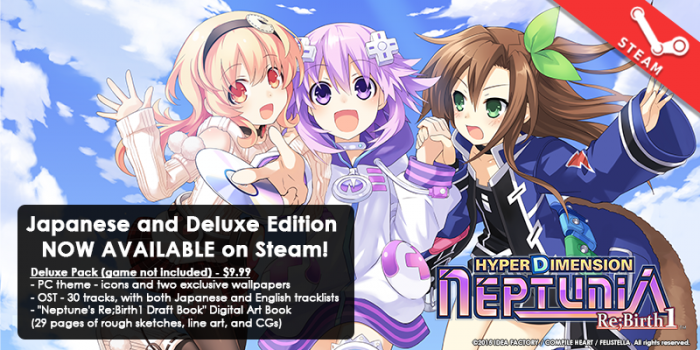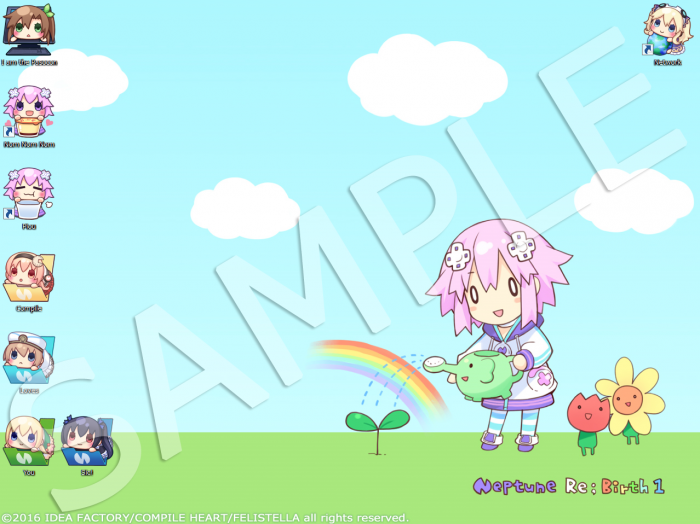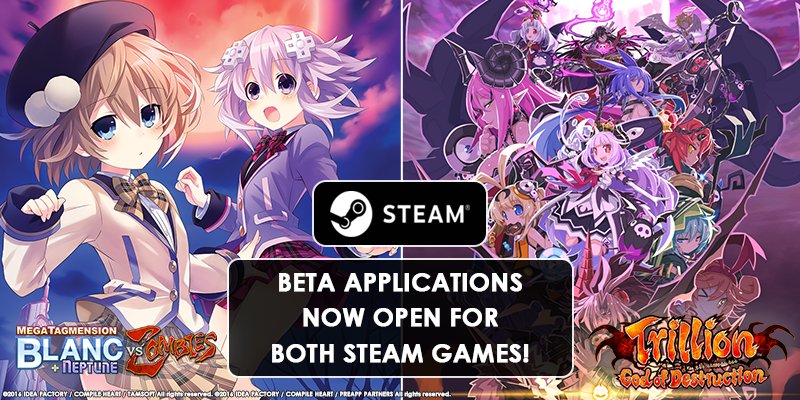Anmelden
?
App installieren
So installierst du die App auf iOS
Im folgenden Video siehst du, wie du consolewars als Web-App auf dem Startbildschirm deines Smartphones installieren kannst.
Hinweis: This feature may not be available in some browsers.
You are using an out of date browser. It may not display this or other websites correctly.
You should upgrade or use an alternative browser.
You should upgrade or use an alternative browser.
Vita Hyperdimension Neptunia Stammtisch
- Thread-Ersteller Kiera
- Erstellungsdatum
-
- Tags
- fantasy neptunia stammtisch vita
Itoshiki
L16: Sensei
Sehr geil! 

Sehr geil!
ja ist Geil ;-)
bin auch gespannt wenn paar neue news wegen den Cyberdimension Neptunia Online Game kommen, obs jetzt wirklich Online Only ist oder nur Online Simuliert wird. wird aber noch ne weile dauern bis na was neues kommt
- Seit
- 1 Mai 2007
- Beiträge
- 81.013
- Xbox Live
- Kiera Salter
- PSN
- VegetaEx
- Switch
- 079910150123
- Steam
- VegetaEx
Ich warte jetzt wieder ein paar Jahre und kaufe dann alle Spiele nach, hab immer noch keins abgeschlossen und da wird sich auch nicht ändern 

- Seit
- 1 Mai 2007
- Beiträge
- 81.013
- Xbox Live
- Kiera Salter
- PSN
- VegetaEx
- Switch
- 079910150123
- Steam
- VegetaEx
Next Neptunia Game Cyber Dimension Online Isn’t Actually An Online Game
-Quelle
Compile Heart recently revealed Cyber Dimension Online as the latest of the Neptunia series, and this week’s issue of Dengeki PlayStation provides us with more information on the upcoming title. [Thanks, Hachima and Otakomu.]
This time around, the gmae will take place in a brand new orthodox-style fantasy world, where you’ll see Neptune and her friends in a different appearance than what you might be used to.
The looks of our main characters are designed by Tsunako, and they’re said to perfectly fit the world setting:


- Neptune x Holy Knight
- Noire x Dark Knight
- Blanc x Priest
- Vert x Enchanter
Here are some notes from executive producer Norhisa Kochiwa, designer Tsunako, and producer Naoko Mizuno:
- This time around, they’re working on a “fantasy version” of Neptune that will depict them in a different way.
- The title has “Online” in it, but it’s in fact not an online game, but actually about a game where Neptune and friends are playing one instead.
- The genre is action RPG.
- This is the game that Vert plays in the main Neptunia games, but she won’t be the main character, although she may play a bigger role.
- The four goddesses will join as allies bits at a time, but it won’t take long until you get everyone together in your party.
- As for other characters that will make an appearance, please look forward to it [in the next report or preview].
- The story starts out with the Neptune and friends playing “Four Goddesses Online” and they begin to notice the existence of new characters, and fight against those that are enemies. And there will be one that is similar to Arfoire.
- Development is about 20% to 30% complete. It’ll likely release in winter 2016.
A platform for Cyber Dimension Online has yet to be announced.
-Quelle
Also so wie .Hack und SAO Simuliertes Online Game
- Seit
- 1 Mai 2007
- Beiträge
- 81.013
- Xbox Live
- Kiera Salter
- PSN
- VegetaEx
- Switch
- 079910150123
- Steam
- VegetaEx
Hyperdevotion Noire: Erst mit Verspätung bei Steam
-Quelle
Noire benötigt noch ein wenig mehr Zeit, um sich für ihren großen Auftritt bei Steam vorzubereiten. Wie der Publisher Idea Factory meldet, wird die Veröffentlichung von Hyperdevotion Noire: Goddess Black Heart bei Steam verschoben. Geplant war der 18. April als Tag der Erscheinung, nun soll das strategische Rollenspiel am 26. April für PCs erhältlich sein. In der ersten Woche winkt ein Rabatt in Höhe von 40 Prozent auf den Verkaufspreis.
-Quelle
- Seit
- 1 Mai 2007
- Beiträge
- 81.013
- Xbox Live
- Kiera Salter
- PSN
- VegetaEx
- Switch
- 079910150123
- Steam
- VegetaEx
Hyperdimension Neptunia Editor Nick Doerr Talks Localization
-Quelle
Nick Doerr, developer of Undead Darlings, did a Q&A with NicheGamer’s readers about his past work as editor for the Hyperdimension Neptunia games with NIS America. The interview delves into why several decisions were made in regards to Hyperdimension Neptunia’s localization, and why they get made for localizations in general.
Why so many memes? I personally feel like the times in memes in official translations have sort of passed by compared to the days of the Ace Attorney games on DS, although I ain’t gonna lie, I did chuckle at some of them. But still, I do feel like the time for using them in retail releases has passed, as they sort of date the games’ humor.
I’m glad this is the first question listed, actually. Before I can answer the question itself, it gives me a good opportunity to talk briefly about the entire process that leads up to the “why” bit. While I’m not throwing anyone under the bus here, it’s probably for the best that I don’t name names—although it’s no mystery where I used to work, it’s often seen as better to be discreet when talking about how stuff worked on the inside while I was there.
The next few paragraphs talks about how Neptunia first came over; it’s not a complete account, just my own. Feel free to skip it and go on to the paragraph that starts with TL;DR if you’re not interested. I think it’s a fun story, though. Haven’t told it quite like this before.
So. Go back to sometime in 2010, when the very first game in the Neptunia series was being pitched to my then-employer. Games from the company pitching Neptunia were not viewed highly at the time, and after average to harsh reviews of previous titles (yes, reviews do carry weight with certain things within such companies), the default response was to pass on the game. I thought it looked like a novel idea, so I kept bugging the then-president to consider the title; he asked if I could show that there was a market for it.
I started posting about the game (after the Japanese announcement of its existence, of course) on the company forums and a lot of people joined in. It quickly became one of the most popular threads on the company forums… Next thing you know, the company decided to pursue the license and Neptunia made its way to the states. I’m NOT saying it was thanks to me, but I do feel like I lent a helping hand when the developer didn’t have a stateside presence of its own. Maybe my actions had no effect, but the fact remains that myself and many others wanted to see it come to the US—and it did.
Now then, the game is licensed. It’s time for the localization team to get together for a “kick-off meeting,” where the game’s genre, tone, mechanics, and characters are described. This meeting was often led by the producer of the US publisher. During this meeting, it was decided by everyone that the Neptunia game was a modern pop-culture title steeped in Internet lore and fanboyisms, due to its paper-thin console war allegory and based on the jokes and references in the Japanese script (which I can’t read). I have some links to share that support these conclusions in a bit.
Also during this meeting, depending on how on-the-ball the localization manager was, the team members working on the game would also be announced. For this game, the editor was chosen to be me because of my presence surrounding the game already (forums, championing its localization in the first place), and the translator was chosen to be one of the senior translators at the time. We began to work on the game shortly after, and since this was the first title, we had to talk about name localizations, the game title, and how to bring their personalities across between languages.
I had no idea why we couldn’t call the game Hyperdimension Neptune. There were fears of copyright claims and lawsuits (this was during the time when people were getting sued for using the word “Edge” in their games—one such game was sued at this publisher for it and was taken off shelves for quite some time), so we did what we had to do and settled on a new name using non-words. My internal effort was to keep it as close to the original name as possible, and changing an –e to –ia seemed to appease the upper management, so there that was.
This was also where we decided on Arfoire for the US name of Magiquone, Console Patron Unit (CPU), and kind of sets up where the next paragraph is going: the localization process where I worked was focused on “giving US gamers the same experience as JP gamers,” which is very different from a straight translation, or “giving US gamers the JP game in English.” That was the company process, and I was a part of it. Not the producer, not the manager, not the translator—an editor.
While I’m on it, the whole idea of CPU as Console Patron Unit was decided on because I was told that, in the original game, the kanji used to describe the girls as “hardware goddesses” was just that—it was both a technological term and a deification. So instead of using the direct “Hard Goddess” (heh), we settled on acronyms that exist in technology while giving them a more deified meaning. This trend, once established, has to carry through all of the titles for consistency within the company, which is why you see things like CFW (Criminals of the Free World) and DoS (Deity of Sin) crop up. Tonal consistency, I guess is what we called it.
TL;DR: That brings us to the part where text localization begins in earnest. First, you must understand that I am not a translator. The Japanese script is given to the translator, who turns it into English (kinda-sorta, depending on their fluency) and adds notes to help the editor when polishing their translation. Notes like “this is a pun having to do with the kanji used in her name and a fish” or “this is referencing a Pepsi commercial that aired in Japan during the 1980s” (yes, that was an actual note), or even “2ch meme.” So to answer your question of why there were so many memes: ask Japan.
Given that I’ve described our process to this point, keep in mind:
· The tone of the game had been decided as pop-culture, Internet geek, and console war
· The company process is to give US gamers the same experience as JP gamers
The second bit in particular is important here. Memes, when directly translated from one language to another, lose all meaning and, almost universally, the context in which they are used falls flat. So to give US gamers the same experience as JP gamers, we had to find memes that exist in the US and put them in the dialogue as close to where the original meme was brought up. Sometimes this resulted in heavy rewriting to get the joke to work, but that’s localization; if there’s a joke in Japanese, it needs a joke in English. A bad joke for a bad joke, a good joke for a good joke.
Don’t believe that Japan inundated their script with memes? Here’s a link to a JP wiki by Japanese gamers that was used as a reference point for the translator on Neptunia Victory: all you need to do on there is ctrl+f “2ch” and there are your Japanese memes that originated from that online message board. Other memes exist on that wiki, but they may have originated elsewhere; the 2ch search is the fastest way of showing that memes were used in the US because memes were used in Japan. Here’s a link to the original game’s wiki, also.
I agree that using memes in retail titles is dating. When you also consider that the time the game is received by the US staff and the time of the game’s release are nearly one year apart, the game is actually dated by the time it comes out. Not to mention when a game is re-released several years later with much the same script (hint hint). One major thing to keep in mind, not just with me, but with translation teams everywhere—we are not supposed to write ourselves, our opinions, or our feelings into the games we work on. But that doesn’t mean we don’t fail; everyone has done this to some degree, even if it’s as internalized as word choice or syntax.
There is no 1:1 translation because everyone has a different vocabulary or will piece sentences/ideas together differently. And because I’m not a translator, I have no idea how sincere or direct the translator’s translation is, either. My point is that I don’t like using references as humor and I’m trying to write more original content in my own game; there are movie and game references, but not as punchlines. When criticizing or critiquing the work others have done, try to keep in mind that they may personally agree with you, but they also have to do their job and have to do their best at it.
-Quelle
- Seit
- 1 Mai 2007
- Beiträge
- 81.013
- Xbox Live
- Kiera Salter
- PSN
- VegetaEx
- Switch
- 079910150123
- Steam
- VegetaEx
MegaTagmension Blanc + Neptune VS Zombies Campaign Is The Best Place To Start
-Quelle
When you first start playing MegaTagmension Blanc + Neptune VS Zombies on a PlayStation Vita, you’re faced with a very serious decision. You can go through a campaign and figure out what’s going on in Gamicademi and how to save it or head online and start tackling missions with strangers and friends. It’s super tempting to go for the latter, believe me. Every character is unlocked and it’s a much easier means of earning money for equipment, accessories, and upgrades. Sticking with the story, at least for the first two hours, is the best decision.
Part of it is due to the way MegaTagmension Blanc + Neptune VS Zombies eases you into altercations. The first few story missions are incredibly simple. You’re forced to focus on Blanc, Neptune, Nepgear, Ram, Rom, and Tamsoft and learn how each one functions in the field. You get a feel for the partnership and see how some basic enemies attack. Since there’s some repetition with these characters, learning how initial mooks behave is pretty beneficial. You learn how to trigger special attacks and get a feel for behavior.
Plus, going through the MegaTagmension Blanc + Neptune VS Zombies gives you a chance to start leveling some characters up. Blanc and are the most solid early characters. They have simple combos and deal tons of damage. It’s a good idea to have one of them set as your initial character, then pick someone slightly different or unconventional, like Tamsoft, Ram, Rom, or Uni, to switch to during play. You’ll appreciate that experience.
It also means you’re better prepared for the boss fights. I’m unsure if everyone’s experience will be identical, but the first boss I faced in MegaTagmension Blanc + Neptune VS Zombies’ campaign was also the first to show up when I went into multiplayer matches. The first time I encountered him, it was after I went searching for a room and found someone else actually playing. I was so happy to have this opportunity that I stuck around as long as possible, even though it meant I was woefully unprepared for that battle. (Fortunately, my ally was at about the same level as me, so I didn’t have to deal with the guilt of letting someone else down.)
But the best reason to start with the Story is for the encounters. The characters from Neptunia are pretty amazing, with unique personalities. We all have our favorites. Heading into the campaign means you get to see why all these CPUs and CPU candidates aren’t ruling their respective nations and are instead attending a high school. Sure, it’s a flimsy excuse to put them all in school uniforms and send them out after zombified versions of iconic enemies from the series. But it’s full of the same inside jokes and clever quips as the rest of the series.
It’s a great time to get screenshots too. Pressing the down button immediately pauses the action and brings up camera options. You can change the position, zoom in or out, alter the angle, and grab the perfect picture of your favorite CPU or CPU candidate in action. You can take the time to halt everything and see if you can take a pretty neat picture, which you could save for yourself to show off, share, or even use as a background.
The MegaTagmension Blanc + Neptune VS Zombies’ story mode problems really have to do with the pacing. Perhaps it’s just me and due to my swapping between modes, but it feels like it takes a bit longer than necessary to start unlocking additional characters. It starts off swiftly enough, with Blanc, Neptune, Nepgear, Ram, Rom, and Tamsoft immediately opting to join the film club and defeat zombies. But then, it tapers off. Instead of getting more CPUs in the third Scene (aka chapter), Dengekiko and Famitsu join up. Noire and Uni don’t arrive until Scene 4, and Vert doesn’t appear until Scene 5.
This wouldn’t be so bad if Scenes were uniform and you knew exactly what to expect from each one, but they’re not. As time goes on, they get longer and longer. MegaTagmension Blanc + Neptune VS Zombies’ first Scene only has one Cut (battle). Scene 2 has three, Scene 3 has four, Scene 4 has five, and so on. The further you go, the longer you have to wait before getting new characters or transformed versions of each one.
After Scene 5’s first Cut is a good time to start transitioning from MegaTagmension Blanc + Neptune VS Zombies’ campaign to multiplayer. You’ll know what you’re doing, be prepared to start fighting bosses, and have an idea of which character would work best for you. Then, you can start racking up wealth from those experiences with up to four players to get weapons that will make it easier to keep quickly advancing through story levels without feeling like you have to go back and level grind.
MegaTagmension Blanc + Neptune VS Zombies will come to the PlayStation Vita in North America on May 10, 2016 and Europe on May 13, 2016.
-Quelle
Chronoswelle
L06: Relaxed
- Seit
- 14 Mai 2015
- Beiträge
- 336
Wie ist denn eigentlich der SRPG-Teil, der kürzlich auf Steam erschien? Das die Charaktere sich ständig gegenseitig küssen hat mich erstmal abgeschreckt.
Zuletzt bearbeitet:
- Seit
- 1 Mai 2007
- Beiträge
- 81.013
- Xbox Live
- Kiera Salter
- PSN
- VegetaEx
- Switch
- 079910150123
- Steam
- VegetaEx
Superdimension Neptune VS Sega Hard Girls’ Heroines Embody Our Favorite Consoles
-Quelle
When it comes to anthropomorphic consoles in our games, JRPG fans know who our goddess and goddess candidates are. We’ve seen eight games in the Hyperdimension Neptunia series by this point, after all. Neptune, Noire, Blanc, Vert, Nepgear, Uni, Rom, and Ram are household names in the right circles. Superdimension Neptune VS Sega Hard Girls is increasing our pantheon when it comes to the PlayStation Vita this year. It takes us through a dungeon crawler where the Hyperdimension Neptunia goddesses and Sega Hard Girls both exist and it’s up to IF and Sega Hatsumi, an entirely new heroine, to work with people we do and don’t know to restore the Grand Library and visit different eras and times to set things right.
But, we don’t have to wait until Superdimension Neptunia VS Sega Hard Girls’ characters that are new to us. The Hi-sCoool! Seha Girls anime is available on Crunchyroll, allowing us to meet these women before their western game debut.
It’s best to start with Dreamcast, as she’s Hi-sCoool! Seha Girls’ heroine. She’s based on the Sega Dreamcast and, at a glance, looks a lot like Ulala from Space Channel 5. She also happens to have a Dreamcast controller with a VMU in it in her headdress, which is pretty difficult to miss, and the Dreamcast spiral logo as her belt buckle. In terms of her outfit, it has a lot in common with Orange Heart’s attire, as it’s white with orange highlights. Her weapon is more dramatic than Uzume Tennouboshi’s megaphone, as she has a sword with a VMU in the hilt and the Dreamcast spiral on it.
Dreamcast is a very energetic, upbeat young woman. Perhaps a bit to the extreme, as she’s interested primarily in having fun and enjoying good food. This is exemplified by her recklessness, as she often engages in some friendly fire in the anime and had a tendency to fall and trip.
Saturn is Hi-sCoool! Seha Girls’ second biggest character. She’s a physical manifestation of the Sega Saturn. She has the Saturn’s red “S” logo on her collar and boots, the controller’s action buttons on the left side of her white vest, and her two staves have the “S”s around blue orbs. She has heterochromia eyes, with one blue and the other green.
When it comes to the anime, it does a wonderful job of making sure Saturn (the character) goes through many of the same things as Saturn (the console). She’s probably the most normal of the whole cast, though she may be a bit overconfident. Which always works against her. She starts out ahead of the other girls in school, but quickly falls behind. (Just like the real Saturn!) When she tries to do things to ingratiate herself with people, it’s rejected where Dreamcast’s advances would be. A great example is episode nine of the anime. While Dreamcast and Mega Drive get super lucky in Chain Chronicle and get 5-star cards, Saturn’s is 1-star. She’s a classic underdog heroine with magic abilities.
The third Sega Hard Girls console is Mega Drive. Like Plutia, she represents the Sega Mega Drive/Sega Genesis. She carries a 16-Bit book, whose title is strikingly similar to the 16-Bit gold lettering emblazoned across the top of the console. Her left sleeve has the three ABC action buttons on it as accessories, as do her hairclip and shoe straps. Her color scheme is black, white, and pink, referring to the system’s black background, red accents, and white logos.
In terms of personality, she’s studious, stoic, and passionate about the things she cares about. She’s considered the most aloof of the three primary heroines in Hi-sCoool! Seha Girls, because the Dreamcast and Saturn consoles were more popular than it was in Japan. She could be considered the most determined member when she sees a fight she want to win or a cause to back, such as when she rails against smart phones or finds herself in an advantage in a fight. Her book is, naturally, her weapon.
Then, there’s Game Gear. She’s Nepgear’s counterpart and represents the Sega Game Gear. Her hair is red, green, and blue, referencing the colors in the ovals on the handheld’s screen. Her entire outfit is a black, bulky outfit. She even has an antenna on her back, as a nod to the handheld’s TV tuner. Though personally, I think a great nod would have also had her image fading in and out, as all three of the Game Gears I’ve owned have had the screens eventually die on me. Her backpack straps have the Game Gear Start button on the left strap and oval icons on the right, and the bottom left of her jacket has two buttons resembling the handheld’s 1 and 2 buttons.
To be honest, we don’t get to know as much about Game Gear in Hi-sCoool! Seha Girls. She isn’t as involved in the story as Dreamcast, Saturn, and Mega Drive. Like the Game Gear, she doesn’t have much energy. She stays inside a lot, resting and relaxing, and doesn’t show much emotion. Basically, she doesn’t seem to have much time for the other characters’ antics in the show, though she does get pulled along sometimes, with episode eight showing her participating in the cultural festival.
Each of the Hi-sCoool! Seha Girls have personalities as intricate and defined as Hyperdimension Neptunia’s goddesses. Their quirks and natures will definitely make for some interesting storylines and antics once Superdimension Neptune VS Sega Hard Girls arrives this fall, especially since so many characters have a direct counterpart in the Neptunia universe.
Superdimension Neptune VS Sega Hard Girls will come to North American and European PlayStation Vitas in fall 2016.
-Quelle
neue Scans von Cyberdimension
Nepgear, Noire, Ram und Rom


ich fände es cool wenn mal so ein 8-16bit Klassiker kommen würde, was so immer im Abspann der Neptunia reihe kommt.
eine mini Sammlung verschiedener Genres JRPG, Sidescroller usw
Nepgear, Noire, Ram und Rom


ich fände es cool wenn mal so ein 8-16bit Klassiker kommen würde, was so immer im Abspann der Neptunia reihe kommt.
eine mini Sammlung verschiedener Genres JRPG, Sidescroller usw
Zuletzt bearbeitet:
- Seit
- 1 Mai 2007
- Beiträge
- 81.013
- Xbox Live
- Kiera Salter
- PSN
- VegetaEx
- Switch
- 079910150123
- Steam
- VegetaEx
NepuNepu Connect: Chaos Chanpuru is a free-to-play card battle game for PS Vita [Update]
-Quelle
[video]https://i.imgur.com/nfQIgXW.jpg[/video]


NepuNepu Connect: Chaos Chanpuru is a free-to-play card battle game (with item micro transactions) for PS Vita due out in Japan in 2016, the latest issue of Dengeki PlayStation reveals.
The recently announced game features over 100 popular Compile Heart characters, as well as a new heroine and original story that throws together the characters of each work. 2D card battles are controlled by touching and dragging on the PS Vita touchscreen.
The main heroine is a girl named Yuriina, designed by Manamitsu, who in order to save the world of chaos from the threat of chaos energy, sets off on a journey in search of the gold fragments.
Characters confirmed to appear include:
Fairy Fencer F
- Fang
- Eryn
Neptunia
- Neptune
- IF
- Compile
Trillion: God of Destruction
- Faust
Omega Quintet
- Momoka
- Kyouka
-Quelle
[video]https://i.imgur.com/nfQIgXW.jpg[/video]


- Seit
- 1 Mai 2007
- Beiträge
- 81.013
- Xbox Live
- Kiera Salter
- PSN
- VegetaEx
- Switch
- 079910150123
- Steam
- VegetaEx
[video=youtube;d6dG2drMlCI]https://www.youtube.com/watch?v=d6dG2drMlCI[/video]





